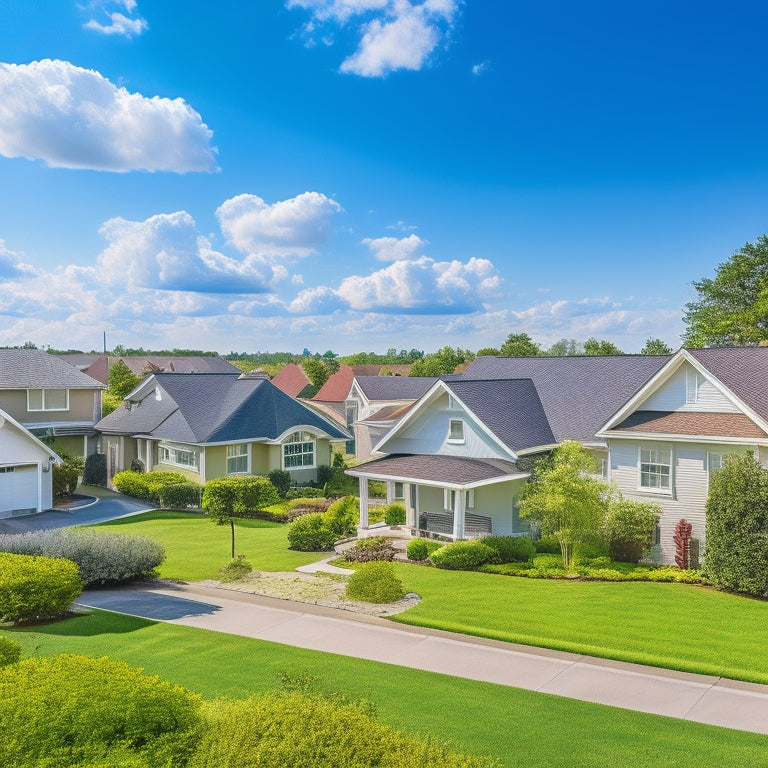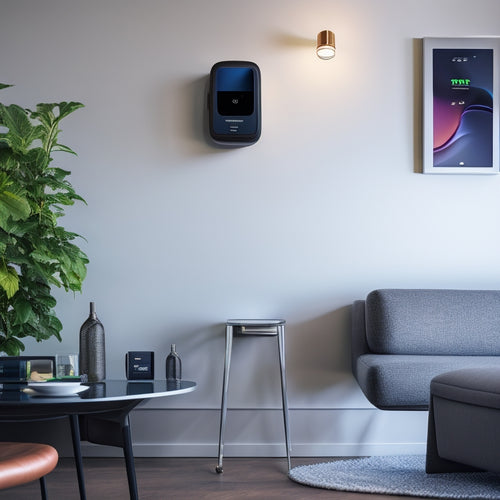
What Cool Roof Tax Breaks Can Homeowners Claim?
Share
You can claim federal tax credits of up to $500 and state and local incentives for installing cool roofs, which not only reduce your energy bills but also contribute to a more sustainable environment. These credits can be claimed on Form 5695, and you'll need to keep receipts, invoices, and manufacturer certifications to document your investment. Additionally, you may be eligible for rebates from government agencies and utility companies, as well as local incentives like property tax exemptions and priority permitting. By exploring these opportunities, you can further maximize your savings and environmental impact, and there's more to uncover about how to make the most of cool roof tax breaks.
Key Takeaways
- Homeowners can claim a federal tax credit of up to 10% of the cost of cool roof installations, capped at $500, on Form 5695.
- State and local governments offer additional tax credits, rebates, and incentives for cool roof installations, varying by region.
- Cool roof rebate programs from government agencies and utility companies can provide direct refunds or discounts on installation costs.
- Homeowners can claim tax deductions for energy-efficient equipment, insulation improvements, and weatherization under the Energy Policy Act of 2005 and the Emergency Economic Stabilization Act of 2008.
- Roof replacement tax breaks are available for costs associated with cool roof installation, providing quicker returns on investment for homeowners.
Federal Tax Credits Available
Your cool roof investment may qualify for federal tax credits, which can greatly offset the cost of installation. These credits are part of federal incentives designed to promote energy-efficient home improvements.
Similarly, electric vehicle loan interest deductions can also contribute to a cleaner environment and support sustainable transportation modes.
To take advantage of these credits, you'll need to keep track of your expenses and documentation during tax filing. Make sure to save receipts and invoices related to your cool roof installation, as well as any manufacturer certifications or product labels.
When filing your taxes, claim the credit on Form 5695, Residential Energy Credits. Be sure to follow the instructions carefully and accurately calculate your credit amount.
State and Local Incentives
You'll also want to investigate state and local incentives for cool roof installations, which can provide additional savings.
Research specific incentives available in local areas to maximize savings, as incentives vary greatly by region. Local rebate programs, for instance, offer a direct refund for a portion of the cool roof's cost utility discounts and time-of-use pricing.
Additionally, state tax credits and municipal incentives may be available, depending on where you live.
Local Rebate Programs
Beyond federal incentives, many state and local governments offer rebate programs specifically designed to encourage homeowners to install cool roofs. These programs vary by location, but they can provide significant savings for homeowners who invest in cool roofing materials. By participating in local rebate programs, you can enjoy increased energy efficiency and reduced energy bills, while also contributing to local engagement and community awareness about the importance of sustainable building practices.
| Location | Rebate Program |
|---|---|
| California | California Energy Commission's California Solar Initiative |
| New York City | NYC Cool Roofs Program |
| Florida | Florida Power & Light's Energy Savings Program |
Remember to research and investigate local rebate programs in your area to maximize your savings and contribute to a more sustainable future.
State Tax Credits
In addition to local rebate programs, many states offer tax credits to homeowners who install cool roofs.
These state tax credits can provide significant savings on your tax bill, much like federal incentives that can enhance commercial EV adoption rates by 15% Federal Incentives.
By leveraging a combination of federal and state incentives, homeowners can maximize their savings.
To claim these credits, you'll need to check your state's eligibility requirements, which may include specific energy efficiency standards or roofing material certifications.
You'll also need to gather documentation, such as receipts and manufacturer certifications, to support your tax credit application.
Be certain to review your state's application process and deadlines to make sure you receive the credit you're eligible for.
Municipal Incentives
Installing a cool roof can also make you eligible for municipal incentives, which vary by state and locality. These incentives are designed to encourage sustainable building practices and reduce the urban heat island effect.
Additionally, some states offer incentives for commercial fleets to adopt eco-friendly transportation solutions, such as California HVIP programs that prioritize disadvantaged communities.
You may be able to take advantage of municipal programs, such as:
- Property tax exemptions or reductions for energy-efficient improvements
- Rebates for cool roof installations, often tied to specific energy-saving targets
- Priority permitting for cool roof projects, streamlining the approval process
These community initiatives can help offset the cost of a cool roof, giving you more freedom to invest in sustainable solutions for your home.
Research the municipal incentives available in your area to maximize your benefits.
Cool Roof Rebate Programs
Across the United States, various government agencies and utility companies offer cool roof rebate programs to incentivize homeowners like you to adopt this energy-efficient technology. These programs provide financial incentives to offset the installation costs of cool roof materials, making it more affordable for you to switch to a cool roof.
| Program | Rebate Amount | Eligibility |
|---|---|---|
| Energy Upgrade California | Up to $1,500 | California residents |
| Austin Energy's Cool Roof Rebate | $0.15 per sq. ft. | Austin, TX residents |
| Xcel Energy's Roof Retrofit Rebate | Up to $1,000 | Xcel Energy customers |
| Southern California Edison's Cool Roof Rebate | Up to $0.25 per sq. ft. | Southern California Edison customers |
These rebate programs can help you recoup a significant portion of your cool roof installation costs, making it a more financially viable option for your home.
Energy Star Certified Roofs
You'll want to evaluate Energy Star certified roofs, which meet strict energy efficiency standards and offer significant roof reflectivity benefits.
These benefits include reducing your home's energy consumption and mitigating the urban heat island effect.
By incorporating solar panels and renewable energy sources, you can further decrease your carbon footprint and energy costs.
Energy Efficiency Standards
The Energy Star certification program, a widely recognized benchmark for energy efficiency, sets a high standard for cool roofs. When you opt for an Energy Star certified roof, you're ensuring your roof installation meets rigorous energy efficiency standards.
This means you'll enjoy significant energy savings, reducing your reliance on non-renewable energy sources and minimizing your carbon footprint.
Here are three key benefits of Energy Star certified roofs:
-
Reduced energy consumption: Energy Star certified roofs are designed to reflect solar rays, reducing the amount of heat that enters your home.
-
Lower energy bills: By reducing energy consumption, you'll see a decrease in your energy bills, giving you more financial freedom.
-
Environmental benefits: Energy Star certified roofs help reduce greenhouse gas emissions, contributing to a cleaner, healthier environment.
Roof Reflectivity Benefits
About 70% of the sun's energy that hits a roof is absorbed, causing your home to heat up.
By installing an Energy Star certified cool roof, you can reverse this process. Cool roofs are designed to reflect the sun's energy, rather than absorb it, reducing the amount of heat that enters your home.
This leads to significant energy savings, as your air conditioning system won't have to work as hard to cool your home.
Furthermore, cool roofs have a positive environmental impact by reducing the urban heat island effect and greenhouse gas emissions.
Certification Process Simplified
Obtaining Energy Star certification for your cool roof is a straightforward process that involves meeting specific requirements.
You'll need to guarantee your roof meets the certification requirements, which include a solar reflectance of at least 0.65 and an emissivity of at least 0.80.
To give you a clear idea of the process, here's what's involved:
-
Select a certified product: Choose a cool roof product that has already been certified by Energy Star.
-
Gather required documents: Collect necessary documents, including product specifications and test reports.
-
Submit your application: Fill out the application form and submit it to Energy Star, along with the required documents.
Solar Reflectance Index Benefits
Your roof's Solar Reflectance Index (SRI) measures its ability to reflect solar radiation, keeping your home cooler and reducing energy consumption.
A higher SRI means your roof is more effective at reflecting solar energy, which reduces the amount of heat absorbed by your home. This leads to lower energy bills and a reduced climate impact.
By choosing a roof with a high SRI, you're not only saving money on energy costs, but also contributing to a more sustainable future.
As you consider cool roof options, prioritize those with high SRI values to maximize the benefits of solar reflectance. This will help you make an informed decision that aligns with your values and goals.
Roof Replacement Tax Breaks
As you prioritize high SRI values for your cool roof, you'll want to investigate the financial benefits that come with it.
When replacing your roof with a cool roof, you can claim tax breaks that offset the costs. The benefits are twofold: you'll enjoy energy savings from reduced heat gain in the summer, and your roof will last longer due to reduced thermal stress.
Here are three key advantages of roof replacement tax breaks:
-
Increased energy savings: A cool roof reduces the amount of heat absorbed, resulting in lower energy bills and a reduced carbon footprint.
-
Extended roof longevity: By reducing thermal stress, a cool roof can last up to 50% longer than a traditional roof, saving you money on replacement costs.
-
Financial incentives: You can claim tax credits or deductions for the cost of the cool roof, offsetting the initial investment and providing a quicker return on investment.
Energy Efficiency Upgrades
Beyond roof replacement, you can further optimize your cool roof's energy efficiency by incorporating additional upgrades. These upgrades can lead to significant energy savings and a reduced climate impact. Here's a breakdown of the upgrades and their benefits:
| Upgrade | Benefits |
|---|---|
| Solar panels | Generate renewable energy, reduce energy bills |
| Radiant barrier insulation | Reflect heat, reduce cooling costs |
| Energy-efficient windows | Reduce heat gain, minimize energy loss |
| Smart thermostats | Optimize temperature control, reduce energy waste |
Home Improvement Tax Deductions
The Energy Policy Act of 2005 and the Emergency Economic Stabilization Act of 2008 offer tax incentives for homeowners who invest in energy-efficient upgrades, including cool roofs.
You can claim home improvement tax deductions for qualifying expenditures, which can help reduce your taxable income. To take advantage of these deductions, you'll need to conduct an energy audit to identify areas in your home that can benefit from energy-efficient upgrades.
-
Roofing materials: You can deduct the cost of cool roofing materials, such as reflective coatings or membranes, that reduce heat gain in your home.
-
Energy-efficient equipment: You can also deduct the cost of installing energy-efficient equipment, like solar panels or energy-efficient HVAC systems.
-
Insulation and weatherization: Improvements to your home's insulation and weatherization, such as sealing air leaks or adding insulation to your attic, are also eligible for deduction.
Claiming Cool Roof Tax Credits
You've identified the energy-efficient upgrades your home needs, including a cool roof. Now, it's time to claim the tax credits you're eligible for. The Non-Business Energy Property Credit, also known as the 25C credit, allows you to claim a credit of up to 10% of the total cost of qualified cool roof technologies, with a maximum credit of $500.
| Cool Roof Technology | Energy Savings | Credit Amount |
|---|---|---|
| Asphalt Shingles with Cool Granules | 10-20% reduction in energy consumption | Up to $500 |
| Metal Roofing with Cool Coatings | 20-30% reduction in energy consumption | Up to $500 |
| Clay or Concrete Tiles with Cool Colors | 15-25% reduction in energy consumption | Up to $500 |
| Fiberglass or Polyester Roof Coatings | 10-20% reduction in energy consumption | Up to $500 |
| Reflective Roof Membranes | 20-30% reduction in energy consumption | Up to $500 |
Remember to keep receipts and manufacturer certifications to claim your credits.
Frequently Asked Questions
Can I Claim Cool Roof Tax Breaks on a Rental Property?
You can claim cool roof tax breaks on a rental property, but you'll need to steer through the subtleties of rental property benefits and cool roof incentives, ensuring you meet specific requirements to maximize your deductions.
Do Cool Roof Tax Credits Apply to Existing Homes Only?
While you're upgrading your existing home, you're probably wondering if cool roof tax credits apply only to existing homes. Fortunately, you can claim credits for energy-efficient roof materials on both new and existing homes, promoting freedom to optimize energy efficiency.
Can I Claim Tax Breaks for DIY Cool Roof Installations?
You won't qualify for tax breaks with DIY cool roof installations, as credits require professional installations that meet Energy Star standards; however, you'll still reap cool roof benefits, such as energy savings, so consider consulting diy installation tips for a successful project.
Are Cool Roof Tax Breaks Available for Commercial Buildings Too?
You'll find cool roof tax breaks aren't limited to homes; commercial building incentives exist too, offering significant benefits for business owners who invest in energy-efficient cool roofs, reducing energy costs and environmental impact.
Can I Claim Tax Breaks for Cool Roof Maintenance Costs?
You can claim tax breaks for cool roof maintenance costs, as they enhance the roof's energy efficiency and prolong its lifespan, allowing you to reap continuous cool roof benefits while reducing your taxable income.
Related Posts
-

7 Best EV Battery Health Trackers for Homeowners
You can maximize your electric vehicle's performance and lifespan by leveraging advanced battery health trackers that...
-

7 Blockchain Tools for Home Energy Management
You can utilize blockchain technology to optimize your home's energy management through innovative solutions like blo...
-

7 Smart Air Purification Hacks for Energy-Savvy Homes
You can notably improve your indoor air quality while minimizing energy consumption by implementing strategic air pur...


